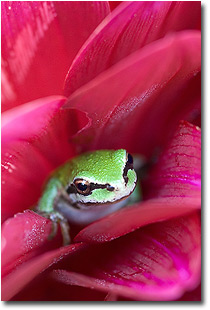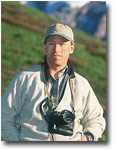Tripod TherapyText and photography copyright Rod Barbee. All rights reserved.
 Therapists tell us we must first look to our own happiness or our relationships are doomed to fail. This is especially true when it comes to the relationship with your tripod. If youíre not happy in your tripod relationship, it will show up most apparently in your photographs. Some people may not realize their tripods are holding them back; that the root of their unhappiness with their own images lies with the tripod theyíve chosen. Why some people choose to stay in a toxic tripod relationship is too deep a subject to cover here, but I can offer some warning signs and suggestions;
Therapists tell us we must first look to our own happiness or our relationships are doomed to fail. This is especially true when it comes to the relationship with your tripod. If youíre not happy in your tripod relationship, it will show up most apparently in your photographs. Some people may not realize their tripods are holding them back; that the root of their unhappiness with their own images lies with the tripod theyíve chosen. Why some people choose to stay in a toxic tripod relationship is too deep a subject to cover here, but I can offer some warning signs and suggestions;
Inflexibility
When photographing wildlife, do you use a perspective thatís too high for the subject? Do your landscape pictures lack interesting foreground? How about close-up pictures, are they poorly done? Do you even have any? Do you have problems setting up on uneven terrain? These are all signs of inflexibility in your tripod. An inflexible tripod is stuck in its own non-compromising, inflexible world; it wonít let you follow your own creativity. One outward sign of this is a tripod that has braces between its legs; this prevents separate leg movement and is a major cause of inflexibility, so watch out for it. If it makes you happy to get down and dirty and close to the ground but your tripod wonít accommodate this need, then itís time to find a tripod that will.
Restrictive or Controlling Behavior
Does your tripod allow you to stand tall or does it force you to bend to its will? If it seems like youíve always got a sore back while photographing and you find yourself tiring quickly, or if youíre never allowed to reach for that perspective you really wanted to share, then your tripod is being too controlling. Get a new one, one that will allow you to express yourself while standing tall and proud. Some tripods will grudgingly allow you to stand tall by extending the center post. Donít be fooled, they do this by compromising stability and itís just another tactic to control your image making.
If your tripod is restricting your creativity, youíll be justifiably tempted into not using it at all. Some photographic signs of this are poor or sloppy compositions, distracting mergers, and tilted horizons. A tripod enables you to study your composition so that you can detect and eliminate such problems. If your tripodís behavior is such that you would just rather not use it, then you need to let that relationship go.
Unsupportive behavior
Have you spent the money on good lenses and you are using a tripod, yet your images still lack sharpness? This is one sign of an unsupportive tripod. Is your tripod a lightweight when it comes to supporting your photographic goals (and your bigger lenses)? Do you find yourself constantly extending your center post because your tripod is too restrictive? Do you worry about your skinny companion blowing over in the wind? If you know what you want, but your tripod wonít give you the support and confidence to just go for it, then itís probably time to let this tripod go and move on to one that is supportive.
Unreliability
Locked legs, loose joints, and missed shots can be signs of unreliability. Have you ever experienced locked legs or loose joints? Have you ever missed a shot because your tripod was being stubbornly defective? Tell the truth. Can you rely on your tripod to really be there for you? If not, itís time to get one that will. If everything works smoothly and works all the time, youíre more likely to use your tripod and more likely to get great photos. Symptoms of tripod unreliability are similar to those of restrictive behavior. If your tripod is unreliable, youíre less likely to use it and your compositions will suffer because of it.
Letting Go
If your tripod wonít allow for separate leg movements or wonít allow you to get close to ground level, get one that will. If your tripod wonít let you stand up comfortably on your own, get one that will. If your tripod wonít give you the support you deserve, just dump it and move on to the next one.
Staying with a restrictive tripod just gives you an excuse for not creating the best images you possibly can, for not being the best photographer you can be. Staying with your tripod just because ďyouíre used to each otherĒ is no excuse at all, it just enables poor photography. Youíll get used to your new tripod and youíll be happier too. Sure, itís going to be painful at first and weíre all frightened by change, but change is good, itís how we grow. So let go of those toxic tripod relationships.
Maintaining Your Relationship
Remember, relationships are two-way streets. You have to do your part in maintaining the relationship. This means giving your tripod the attention it deserves. It means replacing damaged parts, it means tightening up those loose joints and lubricating those locked legs. And donít forget your tripodís head. Without a head, your tripod amounts to three legs just standing around without any direction.
Keeping it Fresh
Once youíve found a tripod that will meet your needs, youíll need to work on keeping the relationship fresh and exciting. Donít let yourself be stuck in a rut. Just because your tripod will go to your eye level doesnít mean it has to all the time. Try sharing different viewpoints with your tripod. Youíll both welcome the change of perspective and your images will show it. Try different positions. Your tripod should be able to get into nearly any position you canóthis may take some imagination on your part but donít be afraid to experiment, itís healthy.
And thereís no rule saying you canít have more than one tripod. Different tripods can fulfill different needs and desires. You may need a large, heavy tripod that can take your longest lens, and you may want to have a more reasonable sized tripod for everyday usage, as well as a lightweight tripod for backpacking. You may even run across situations where youíll want to be using more than one tripod at a time. Tripod relationships need not be monogamous.
Donít be afraid to strike out on your own, either. Try finding compositions without your tripod. This will give you the freedom you need to find new and exciting images, and itís always good to have some time to yourself. Once youíve found the composition you want, go get your tripod and put your new relationship skills to work.
If you havenít been happy in your image making, it may be due to a dissatisfying tripod relationship. If so, go out and find the tripod thatís right for you. Make yourself happy. Once you do, you and your tripod will have a better chance at making great images together.
Comments on NPN nature photography instructional articles? Send them to the editor.
RB-NPN 0933
 Rod Barbee is a professional photographer, writer, and instructor. He is a regular contributor to Outdoor Photographer magazine and has also been published in Natureís Best magazine, Audubon and Mead calendars, Northwest Travel and Oregon Coast magazines, Orvis clothing catalog, the National Park Service, and more. Several of his images appear in the Amphoto book ďAmerican VisionĒ. His first book, The Photographer's Guide to the Oregon Coast, co-written with with David Middleton, is available nationwide. Rod Barbee is a professional photographer, writer, and instructor. He is a regular contributor to Outdoor Photographer magazine and has also been published in Natureís Best magazine, Audubon and Mead calendars, Northwest Travel and Oregon Coast magazines, Orvis clothing catalog, the National Park Service, and more. Several of his images appear in the Amphoto book ďAmerican VisionĒ. His first book, The Photographer's Guide to the Oregon Coast, co-written with with David Middleton, is available nationwide.
Rod has taught nature photography through Bellevue Community College in Washington state, The Mountaineers in Seattle, Olympic College in Bremerton, WA, The Great American Photography Weekend workshops, and Olympic Mountain School of Photography. He is also a contributing editor to Naturephotographers.net, an online photography magazine.
The natural beauty discovered during backpacking trips into Olympic National Park led him to nature photography. It has since become a passion in his life from which he continues to learn and grow.
Rod and his wife Tracy Rowley live in Port Ludlow on Washingtonís Olympic peninsula.


| 


